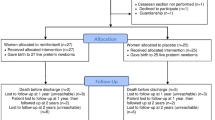Abstract
Purpose
Intravenous infusion of lidocaine attenuates the stress response to surgery. We aimed to evaluate the effects of perioperative lidocaine on the hemodynamic and hormonal responses for cesarean delivery.
Methods
After the gaining of ethical approval, 90 patients scheduled for elective cesarean delivery were randomly allocated to receive either lidocaine 1.5 mg·kg−1 i.v. bolus 30 min before induction, followed by an infusion of 1.5 mg·kg−1·h−1 until 1 h after surgery (n = 45), or saline placebo (n = 45). Anesthesia was maintained with 50% nitrous oxide in oxygen with 0.7% isoflurane. Hemodynamic variables, plasma cortisol, maternal and neonatal lidocaine concentrations, Apgar scores at 1 and 5 min, neonatal acid-base status, and the neurologic and adaptive capacity score (NACS) were recorded.
Results
After induction, patients receiving lidocaine had a smaller increase in heart rate and mean arterial blood pressure (P < 0.02) and lower plasma cortisol concentrations (31.1 ± 9.91 vs 45.6 ± 8.43 μg·dL−1; P < 0.001). There were no differences between the two groups in Apgar scores, NACS, or neonatal acid-base status. After delivery, maternal and umbilical venous concentrations and umbilical vein-to-maternal vein ratios of lidocaine were 2.05 ± 0.42 μg·mL− and 1.06 ± 0.31 μg·mL−1, and 0.52 ± 0.07, respectively.
Conclusion
Perioperative lidocaine is safe and effective in attenuating the maternal stress response to surgery for cesarean delivery.
Similar content being viewed by others
References
Gin T, Ngan-Kee WD, Siu YK, Stuart JC, Tan PE, Lam KK. Alfentanil given immediately before the induction of anesthesia for elective Cesarean delivery. Anesth Analg. 2000;90:1167–1172.
Birch K, Jorgensen J, Chraemmer-Jorgensen B, Kehlet H. Effect of i.v. lignocaine on pain and the endocrine metabolic responses after surgery. Br J Anaesth. 1987;59:721–724.
Omote K. Intravenous lidocaine to treat postoperative pain management: novel strategy with a long-established drug. Anesthesiology. 2007;106:5–6.
Dzikiti TB, Hellebrekers LJ, van Dijk P. Effects of intravenous lidocaine on isoflurane concentration, physiological parameters, metabolic parameters and stress-related hormones in horses undergoing surgery. J Vet Med A Physiol Pathol Clin Med. 2003;50:190–195.
Pypendop BH, Ilkiw JE. The effects of intravenous lidocaine administration on the minimum alveolar concentration of isoflurane in cats. Anesth Analg. 2005;100:97–101.
Abboud TK, Sarkis F, Blikian A, Varakian L, Earl S, Henriksen E. Lack of adverse neonatal neurobehavioral effects of lidocaine. Anesth Analg. 1983;62:473–478.
Cavalli RC, Lanchote VL, Duarte G, Dantas ECM, Prado MFM, Duarte LB, Cunha SB. Pharmacokinetics and transplacental transfer of lidocaine and its metabolite for perineal analgesic assistance to pregnant women. Eur J Clin Pharmacol. 2004;60:569–574.
Nishina K, Mikawa K, Maekawa N, Obara H. Fentanyl attenuates cardiovascular responses to tracheal extubation. Acta Anaesth Scand. 1995;39:85–89.
Caplan YH, Levine B. Application of the Abbott TDx lidocaine, phenytoin, and phenobarbital assays to postmortem blood specimens. J Anal Toxicol. 1988;12:265–267.
Amiel-Tison C, Barrier G, Shnider SM, Levinson G, Hughes SC, Stefani SJ. A new neurologic and adaptive capacity scoring system for evaluating obstetric medications in full-term newborns. Anesthesiology. 1982;56:340–350.
Pandey CK, Raza M, Ranjan R, Singhal V, Kumar M, Lakra A, Navkar DV, Agarwal A, Singh RB, Singh U, Singh PK. Intravenous lidocaine 0.5 mg kg−1 effectively suppresses fentanyl-induced cough. Can J Anesth. 2005;52:172–175.
Yorükoglu D, Aşik Y, Ökten F. Rocuronium combined with i.v. lidocaine for rapid tracheal intubation. Acta Anaesthesiol Scand. 2003;47:583–587.
Fujii Y, Saitoh Y, Takahashi S, Toyooka H. Combined diltiazem and lidocaine reduces cardiovascular responses to tracheal extubation and anesthesia emergence in hypertensive patients. Can J Anaesth. 1999;46:952–956.
Miller CD, Warren SJ. IV lignocaine fails to attenuate the cardiovascular response to laryngoscopy and tracheal intubation. Br J Anaesth. 1990;65:216–219.
Singh H, Vichitvejpaisal P, Gaines GY, White PF. Comparative effects of lidocaine, esmolol, and nitroglycerin in modifying the hemodynamic response to laryngoscopy and intubation. J Clin Anesth. 1995;7:5–8.
Durrani M, Barwise JA, Johnson RF, Kambam JR, Janicki PK. Intravenous chloroprocaine attenuates hemodynamic changes associated with direct laryngoscopy and tracheal intubation. Anesth Analg. 2000;90:1208–1212.
Rehberg B, Xiao YH, Duch DS. Central nervous system sodium channels are significantly suppressed at clinical concentrations of volatile anesthetics. Anesthesiology. 1996;84:1223–1233.
Bach FW, Jensen TS, Kastrup J, Stigsby B, Dejgård A. The effect of intravenous lidocaine on nociceptive processing in diabetic neuropathy. Pain. 1990;40:29–34.
Kaba A, Laurent SR, Detroz BJ, Sessler DI, Durieux ME, Lamy ML, Joris JL. Intravenous lidocaine infusion facilitates acute rehabilitation after laparoscopic colectomy. Anesthesiology. 2007;106:11–18.
Koppert W, Weigand M, Neumann F, Sittl R, Schuettler J, Schmelz M, Hering W. Perioperative intravenous lidocaine has preventive effects on postoperative pain and morphine consumption after major abdominal surgery. Anesth Analg. 2004;98:1050–1055.
Wallin G, Cassuto J, Hogstrom S, Linden I, Faxen A, Rimback G, Hedner T: Effects of lidocaine infusion on the sympathetic response to abdominal surgery. Anesth Analg. 1987;66:1008–1013.
Fauza DO, Kohane DS, Beeuwkes EB, Clayton N, Maher TJ. Local anesthetics inhibit uterine activity in vitro. Possible application on preterm labor prevention and treatment. Fetal Diagn Ther. 2003;18:292–298.
Dirks J, Fabricius P, Petersen KL, Rowbotham MC, Dahl JB. The effect of systemic lidocaine on pain and secondary hyperalgesia associated with the heat/capsaicin sensitization model in healthy volunteers. Anesth Analg. 2000;91:967–972.
Banzai M, Sato S, Tezuka N, Komiya H, Chimura T, Hiroi M. Placental transfer of lidocaine hydrochloride after prolonged continuous maternal intravenous administration. Can J Anaesth. 1995;42:338–340.
Halpern SH, Littleford JA, Brockhurst NJ, Youngs PJ, Malik N, Owen HC. The neurologic and adaptive capacity score is not a reliable method of newborn evaluation. Anesthesiology. 2001;94:958–962.
Author information
Authors and Affiliations
About this article
Cite this article
El-Tahan, M.R., Warda, O.M., Diab, D.G. et al. A randomized study of the effects of perioperative i.v. lidocaine on hemodynamic and hormonal responses for cesarean section. J Anesth 23, 215–221 (2009). https://doi.org/10.1007/s00540-009-0738-3
Received:
Accepted:
Published:
Issue Date:
DOI: https://doi.org/10.1007/s00540-009-0738-3




